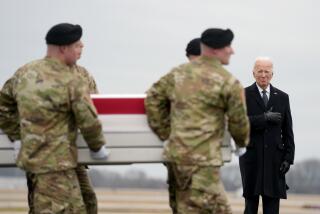Policing the Zones
- Share via
The newly expanded “no-fly” zone takes U.S. air patrols north to within 30 miles of Baghdad. The zone, which was put into effect noon Wednesday (2 a.m. PDT), is off-limits to Iraqi aircraft. Here is how the area, and the other excluision zone in the north, are being monitored by U.S. and allied planes:
* From Turkey: F-16C Falcons out of Incirlik air base
* From Saudi Arabia: F-16C Falcons out of Dhahran
* Aircraft: The 270 aircraft in the Gulf region are split this way:
Air Force: 74%
Navy: 26%
* High Above: Satellites relay ground activity to command center in gulf; AWACS plane monitors troop and weapons movement
* Northern “no-fly” zone: Set up by United Nations to protect Kurds from the Iraqis
* Southern “no-fly” zone: Set up by U.S. and allies to protect Shiite nomads from Iraqis
* From Persian Gulf: Navy F-14s, F/A-18s or EA6Bs coming off carriers
* Size comparison: A pilot in an F-16 could cover the distance between Iraq’s southern border and Baghdad in about 9 minutes.
****
WEDNESDAY DEVELOPMENTS
* U.S. officials reported some movement today of Iraqi troops in the north, as demanded by President Clinton.
* An Iraqi air defense battery beamed its radar at an American warplane. The F-16 jet fighter retaliated with a HARM missile.
* Iraqi MIGs approached U.S. planes from the north, but both of them turned back before they got to the 33rd parallel.
* More than half the Iraqi MiG jets stationed at airbases in the south have moved north.
****
FIRST STRIKE
* Monday: Four weapon and radar sites struck near the Tallil air base.
Why: To punish Iraqi President Saddam Hussein for moving troops into Kurdish-controlled areas in northern Iraq.
* Casualties: Five Iraqis were killed, the Pentagon confirmed. Iraq said a missile hit a housing complex, but the Pentagon denied it.
* Tuesday: Missiles hit two unspecified sites from the first strike.
Why: To destroy targets missed in the first strike.
* Casualties: None confirmed by Pentagon
Quote
“We shall defend our sovereignty with our nails and teeth.”
Iraqi newspaper Babel
Sources: U.S. European Command, Associated Press, Center for Strategic and International Studies, Jane’s All the World’s Aircraft, Times staff
More to Read
Sign up for Essential California
The most important California stories and recommendations in your inbox every morning.
You may occasionally receive promotional content from the Los Angeles Times.










